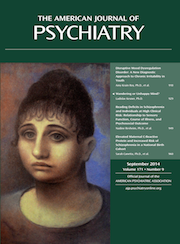Effects of Schizophrenia Risk Variation in the NRG1 Gene on NRG1-IV Splicing During Fetal and Early Postnatal Human Neocortical Development
Abstract
Objective
Neuregulin 1 (NRG1) is a multifunctional neurotrophin that mediates neurodevelopment and schizophrenia risk. The NRG1 gene undergoes extensive alternative splicing, and association of brain NRG1 type IV isoform expression with the schizophrenia-risk polymorphism rs6994992 is a potential mechanism of risk. Novel splice variants of NRG1-IV (NRG1-IVNV), with predicted unique signaling capabilities, have been cloned in fetal brain tissue. The authors investigated the temporal dynamics of transcription of NRG1-IVNV, compared with the major NRG1 isoforms, across human prenatal and postnatal prefrontal cortical development, and they examined the association of rs6994992 with NRG1-IVNV expression.
Method
NRG1 type I–IV and NRG1-IVNV isoforms were evaluated with quantitative real-time polymerase chain reaction in human postmortem prefrontal cortex tissue samples at 14 to 39 weeks gestation and postnatal ages 0–83 years. The association of rs6994992 genotype with NRG1-IVNV expression and the subcellular distribution and proteolytic processing of NRG1-IVNV isoforms were also determined.
Results
Expression of NRG1 types I, II, and III was temporally regulated during prenatal and postnatal neocortical development. NRG1-IVNV was expressed from 16 weeks gestation until age 3. Homozygosity for the schizophrenia risk allele (T) of rs6994992 conferred lower cortical NRG1-IVNV levels. Assays showed that NRG1-IVNV is a novel nuclear-enriched, truncated NRG1 protein resistant to proteolytic processing.
Conclusions
To the authors’ knowledge, this study provides the first quantitative map of NRG1 isoform expression during human neocortical development and aging. It identifies a potential mechanism of early developmental risk for schizophrenia at the NRG1 locus, involving a novel class of NRG1 proteins.



